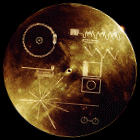 With less than a month to go before the launch of the first of two Voyager unmanned spacecraft, NASA attaches copper phonograph records, encased in lightweight, protective golden casings, to each of the Voyager probes. With participation from Carl Sagan (who led the effort to mount a plaque on the Pioneer probes consisting only of visual information), SETI pioneer Frank Drake, Jon Lomberg and others, the 12″ LP consists of not only sound recordings, but photos and diagrams depicting the diversity and composition of life on Earth. The sounds include various kinds of Earth wildlife, spoken messages from President Jimmy Carter and United Nations Secretary-General Kurt Waldheim, music from Beethoven and Bach to Chuck Berry (the Beatles decline permission to include “Here Comes The Sun”), and Carl Sagan’s young son Nick delcaring “Greetings from the children of planet Earth.” The outer casing includes a playback mechanism and diagrams for how to use it.
With less than a month to go before the launch of the first of two Voyager unmanned spacecraft, NASA attaches copper phonograph records, encased in lightweight, protective golden casings, to each of the Voyager probes. With participation from Carl Sagan (who led the effort to mount a plaque on the Pioneer probes consisting only of visual information), SETI pioneer Frank Drake, Jon Lomberg and others, the 12″ LP consists of not only sound recordings, but photos and diagrams depicting the diversity and composition of life on Earth. The sounds include various kinds of Earth wildlife, spoken messages from President Jimmy Carter and United Nations Secretary-General Kurt Waldheim, music from Beethoven and Bach to Chuck Berry (the Beatles decline permission to include “Here Comes The Sun”), and Carl Sagan’s young son Nick delcaring “Greetings from the children of planet Earth.” The outer casing includes a playback mechanism and diagrams for how to use it.
In the decades to come, fictional aliens visiting or invading Earth because they have viewed the Voyager “Golden Record” becomes a staple of science fiction media.
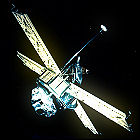 Just two days before its sister ship Mariner 6 makes its closest flyby of Mars, NASA/JPL’s unmanned space explorer Mariner 7 loses all contact with Earth. Ground controllers race to find a solution, re-establishing communications via Mariner 7’s low-gain antenna, which can only return data at a reduced speed and bandwidth. Its high-gain antenna resumes normal operation shortly after Mariner 6’s closest pass by Mars, allowing Mariner 7 to complete its mission as planned.
Just two days before its sister ship Mariner 6 makes its closest flyby of Mars, NASA/JPL’s unmanned space explorer Mariner 7 loses all contact with Earth. Ground controllers race to find a solution, re-establishing communications via Mariner 7’s low-gain antenna, which can only return data at a reduced speed and bandwidth. Its high-gain antenna resumes normal operation shortly after Mariner 6’s closest pass by Mars, allowing Mariner 7 to complete its mission as planned.
 ITV premieres the first episode of Ace Of Wands, starring Michael McKenzie, Tony Selby and Judy Loe. David Prowse (Star Wars) guest stars. This episode, like the rest of the series’ first two seasons, is now missing from the archives.
ITV premieres the first episode of Ace Of Wands, starring Michael McKenzie, Tony Selby and Judy Loe. David Prowse (Star Wars) guest stars. This episode, like the rest of the series’ first two seasons, is now missing from the archives.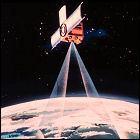 NASA and the National Oceanic & Atmospheric Administration launch NOAA-5, a weather satellite intended to operate in a near-polar low Earth orbit. Within two weeks of its launch, NOAA-5 proves instrumental in tracking Hurricane Belle, a category 1 hurricane, as it approaches and makes landfall in the northeastern United States. NOAA-5 will operate without any major malfunctions through July 1979.
NASA and the National Oceanic & Atmospheric Administration launch NOAA-5, a weather satellite intended to operate in a near-polar low Earth orbit. Within two weeks of its launch, NOAA-5 proves instrumental in tracking Hurricane Belle, a category 1 hurricane, as it approaches and makes landfall in the northeastern United States. NOAA-5 will operate without any major malfunctions through July 1979. With less than a month to go before the launch of the first of two Voyager unmanned spacecraft, NASA attaches copper phonograph records, encased in lightweight, protective golden casings, to each of the Voyager probes. With participation from Carl Sagan (who led the effort to mount a plaque on the Pioneer probes consisting only of visual information), SETI pioneer Frank Drake, Jon Lomberg and others, the 12″ LP consists of not only sound recordings, but photos and diagrams depicting the diversity and composition of life on Earth. The sounds include various kinds of Earth wildlife, spoken messages from President Jimmy Carter and United Nations Secretary-General Kurt Waldheim, music from Beethoven and Bach to Chuck Berry (the Beatles decline permission to include “Here Comes The Sun”), and Carl Sagan’s young son Nick delcaring “Greetings from the children of planet Earth.” The outer casing includes a playback mechanism and diagrams for how to use it.
With less than a month to go before the launch of the first of two Voyager unmanned spacecraft, NASA attaches copper phonograph records, encased in lightweight, protective golden casings, to each of the Voyager probes. With participation from Carl Sagan (who led the effort to mount a plaque on the Pioneer probes consisting only of visual information), SETI pioneer Frank Drake, Jon Lomberg and others, the 12″ LP consists of not only sound recordings, but photos and diagrams depicting the diversity and composition of life on Earth. The sounds include various kinds of Earth wildlife, spoken messages from President Jimmy Carter and United Nations Secretary-General Kurt Waldheim, music from Beethoven and Bach to Chuck Berry (the Beatles decline permission to include “Here Comes The Sun”), and Carl Sagan’s young son Nick delcaring “Greetings from the children of planet Earth.” The outer casing includes a playback mechanism and diagrams for how to use it.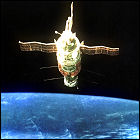 The Soviet Union’s Salyut 6 space station, unoccupied for over a year, re-enters Earth’s atmosphere with the Kosmos 1267 module still docked; both the station and its added module disintegrate over unpopulated ocean.
The Soviet Union’s Salyut 6 space station, unoccupied for over a year, re-enters Earth’s atmosphere with the Kosmos 1267 module still docked; both the station and its added module disintegrate over unpopulated ocean.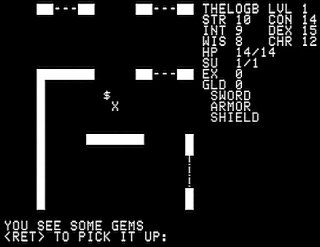 Wargame publisher Avalon Hill’s subsidiary Microcomputer Games Inc. releases the computer role playing game
Wargame publisher Avalon Hill’s subsidiary Microcomputer Games Inc. releases the computer role playing game 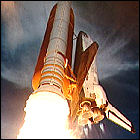 For the first and only time in the history of the shuttle program, Space Shuttle Challenger does an in-flight abort maneuver – in this case, an Abort To Orbit (ATO) following the premature shutdown of one of the shuttle’s main engines. The potentially catastrophic shutdown of a second engine is narrowly avoided by a sharp-eyed ground controller, and Challenger makes it to orbit and the rest of the mission is conducted normally.
For the first and only time in the history of the shuttle program, Space Shuttle Challenger does an in-flight abort maneuver – in this case, an Abort To Orbit (ATO) following the premature shutdown of one of the shuttle’s main engines. The potentially catastrophic shutdown of a second engine is narrowly avoided by a sharp-eyed ground controller, and Challenger makes it to orbit and the rest of the mission is conducted normally.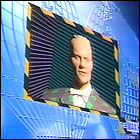 The
The  The 48th episode of the supernatural crime series Forever Knight airs in syndication, starring Geraint Wyn-Davies, Catherine Disher, Nigel Bennett, and John Kapelos. This is the second season finale; the third season will see the series move to U.S. cable channel USA Network.
The 48th episode of the supernatural crime series Forever Knight airs in syndication, starring Geraint Wyn-Davies, Catherine Disher, Nigel Bennett, and John Kapelos. This is the second season finale; the third season will see the series move to U.S. cable channel USA Network. Former Jellyfish guitarist Jason Falkner releases his first solo album,
Former Jellyfish guitarist Jason Falkner releases his first solo album, 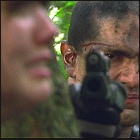 Sci-Fi channel airs the
Sci-Fi channel airs the  Sci-Fi Channel airs the 26th episode of the science fiction series Eureka, starring Colin Ferguson, Salli Richardson, and Joe Morton. Niall Matter (Primeval: New World) guest stars in the third season premiere.
Sci-Fi Channel airs the 26th episode of the science fiction series Eureka, starring Colin Ferguson, Salli Richardson, and Joe Morton. Niall Matter (Primeval: New World) guest stars in the third season premiere. American pay cable channel Starz premieres the
American pay cable channel Starz premieres the 
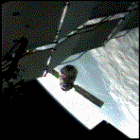 Delayed several days due to technical glitches that occurred after its launch, the Russian Nauka Multipurpose Logisitics Module Upgrade docks with the International Space Station. Some glitches continue to occur during the modules approach and docking phase, with the Russian crew members aboard the station manually intervening when necessary. After docking, however, Nauka’s thrusters begin firing, rotating the station 45 degrees off-axis, eventually exhausting its fuel supply. Once its thrusters are no longer capable of moving the station, the station is restored to its original orientation, with NASA reassuring the public that the event posed no danger to the crew. Some spacewalks will be required to fully connect Nauka’s systems to those of the rest of the station, but it is expected to become the hub of Russia’s research activity aboard the ISS.
Delayed several days due to technical glitches that occurred after its launch, the Russian Nauka Multipurpose Logisitics Module Upgrade docks with the International Space Station. Some glitches continue to occur during the modules approach and docking phase, with the Russian crew members aboard the station manually intervening when necessary. After docking, however, Nauka’s thrusters begin firing, rotating the station 45 degrees off-axis, eventually exhausting its fuel supply. Once its thrusters are no longer capable of moving the station, the station is restored to its original orientation, with NASA reassuring the public that the event posed no danger to the crew. Some spacewalks will be required to fully connect Nauka’s systems to those of the rest of the station, but it is expected to become the hub of Russia’s research activity aboard the ISS.